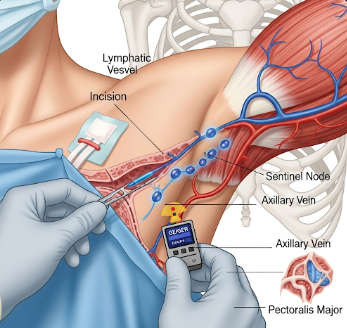Overview
Sentinel Node Biopsy (SNB) is a surgical procedure used to identify and examine the first lymph node(s) that drain a cancerous tumor, known as the sentinel node(s). This procedure is most commonly performed in breast cancer, melanoma, and certain gynecologic cancers to determine if cancer has spread to the lymphatic system.
In Korea, sentinel node biopsy is offered in advanced oncology and surgical centers, combining minimally invasive techniques, precise imaging, and expert pathological evaluation. Korean hospitals are renowned for high accuracy, safety, and rapid post-operative recovery, making them a preferred choice for international patients.
What is Sentinel Node Biopsy?
Sentinel node biopsy involves removing one or more sentinel lymph nodes to examine them for cancer cells. The sentinel node is the first lymph node to receive drainage from the primary tumor, making it the most likely site of early cancer spread.
Key aspects include:
- ✦ Minimally invasive approach – small incision and targeted removal.
- ➤ Use of dyes or radioactive tracers – to identify sentinel lymph nodes accurately.
- ✦ Pathological analysis – determines presence or absence of cancer cells.
- ➤ Guides further treatment – helps decide if full lymph node removal is necessary.
Sentinel node biopsy reduces unnecessary lymph node removal, minimizing complications such as lymphedema.
What are the Benefits?
Sentinel node biopsy offers multiple advantages:
✅ Accurate staging of cancer – determines if cancer has spread to lymph nodes.
➤ Minimally invasive – smaller incisions and less tissue disruption.
✦ Reduces risk of lymphedema compared to full lymph node dissection.
➤ Guides treatment decisions – chemotherapy, radiation, or surgery planning.
✅ Quick recovery – outpatient or short hospital stay depending on case.
✦ Improved quality of life – fewer post-operative complications and faster return to daily activities.
Procedure Details
1) How should I prepare for Sentinel Node Biopsy?
Preparation steps include:
- ✦ Pre-operative imaging – ultrasound, mammography, MRI, or CT to locate the tumor.
- ➤ Tracer injection planning – radioactive material or dye will be used to map lymph nodes.
- ✦ Medical evaluation – blood tests, review of medications, and anesthesia assessment.
- ➤ Discussion with surgeon – procedure details, risks, and expected outcomes.
- ✦ Fasting – typically 6–8 hours before surgery.
- ➤ Consent and counseling – understanding potential need for additional lymph node removal.
2) What happens during the procedure Sentinel Node Biopsy?
The procedure is usually performed under general or local anesthesia and takes 30–90 minutes depending on tumor location:
➤ Step 1: A tracer (dye or radioactive substance) is injected near the tumor site.
✦ Step 2: The tracer travels through lymphatic channels to the sentinel node(s).
➤ Step 3: Using a gamma probe or visual identification, the surgeon locates the sentinel lymph nodes.
✦ Step 4: One or more sentinel nodes are carefully removed through a small incision.
➤ Step 5: Nodes are sent to pathology for microscopic evaluation to check for cancer spread.
The procedure is highly targeted, minimizing tissue removal and preserving lymphatic function.
3) What happens after a Sentinel Node Biopsy?
Post-operative care includes:
- ✦ Short hospital stay – often outpatient or 1 day.
- ➤ Pain management – mild analgesics for incision discomfort.
- ✦ Wound care – keep incision clean and dry, watch for signs of infection.
- ➤ Activity restrictions – avoid heavy lifting for 1–2 weeks.
- ✦ Follow-up visits – review pathology results and determine next steps in cancer treatment.
- ➤ Lymphedema monitoring – although risk is low, patients are advised on early detection.
Most patients resume normal activities within days, depending on overall health and concurrent procedures.
Risks / Benefits
Potential Risks:
- ✦ Mild pain, swelling, or bruising at incision site.
- ➤ Infection at surgical site.
- ✦ Bleeding or hematoma formation.
- ➤ Rare allergic reaction to dye or tracer.
- ✦ Very low risk of lymphedema or nerve injury.
Benefits:
- ✅ Accurate cancer staging with minimal intervention.
- ✅ Reduces unnecessary lymph node removal.
- ✅ Guides individualized treatment plans.
- ✅ Minimally invasive with quick recovery and fewer complications.
Recovery and Outlook
Recovery from sentinel node biopsy is generally smooth:
- ➤ Hospital stay: outpatient or 1 day.
- ✦ Pain management: mild discomfort, controlled with standard analgesics.
- ➤ Return to daily activities: usually 2–5 days.
- ✦ Long-term outcome: excellent, providing accurate staging and guiding treatment decisions.
- ➤ Quality of life: minimal scarring and reduced post-operative complications.
Pathology results guide whether further lymph node removal or additional therapy is needed.
When To Call the Doctor
Patients should contact their healthcare provider if they notice:
⚠ Fever, chills, or signs of infection.
⚠ Persistent swelling, redness, or bleeding at the incision site.
⚠ Severe pain unrelieved by medication.
⚠ Numbness, tingling, or other nerve-related symptoms.
⚠ Signs of lymphedema in the arm, leg, or area surrounding the surgical site.
Best Korea Option / Process
Korea provides world-class sentinel node biopsy care with:
- ✦ Experienced oncologic and surgical teams specializing in breast, melanoma, and gynecologic cancers.
- ➤ Advanced imaging and tracer technologies for accurate node identification.
- ✦ Minimally invasive techniques for precise removal and faster recovery.
- ➤ Comprehensive post-operative monitoring including pathology and follow-up care.
- ✦ Affordable treatment packages for international patients.
- ➤ Multidisciplinary support teams including oncology, nursing, and counseling for optimal patient outcomes.
Korea is a leading destination for sentinel node biopsy, offering safe, effective, and precise cancer staging with excellent recovery and low complication rates.
Highlights of Sentinel Node Biopsy in Korea
- ✅ Accurate cancer staging with minimal lymph node removal.
- ➤ Reduces risk of lymphedema compared to full node dissection.
- ✦ Minimally invasive, outpatient-friendly procedure.
- ➤ Performed by top Korean oncologic surgeons with advanced imaging support.
- ✅ Quick recovery with short hospital stay and minimal complications.













